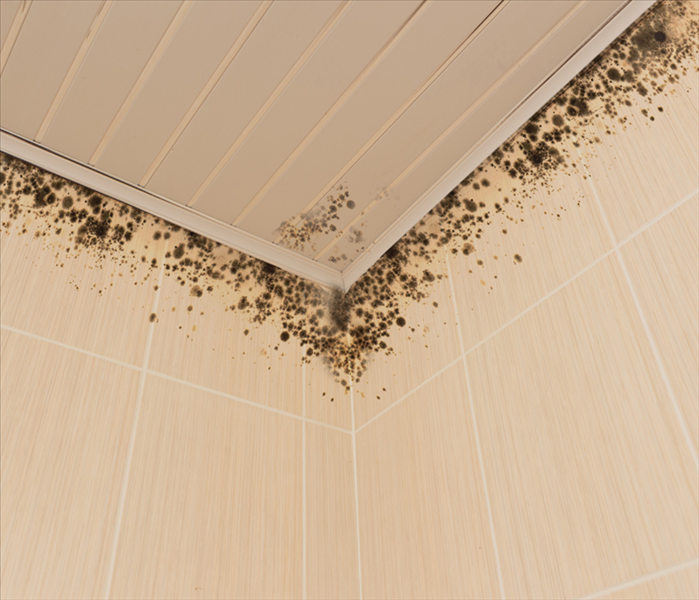Trust SERVPRO for Mold Removal in Your Home
5/13/2021 (Permalink)
Mold is all around us, all the time. Found both indoors and outdoors throughout the year, mold is simply a part of our world.
That being said, mold growing in your home is a big problem that typically indicates that there is a source of moisture or water in your home that needs to be dealt with.
What Is Black Mold?
"Black mold" actually refers to a number of species of mold that have either a black or dark green appearance. One type of mold that falls under this category is known as Stachybortrys chartarum.
Mold is a type of fungus that drives in warm and moist environments. Places where mold is eager to grow include kitchens, bathrooms, toilets, showers, and basements. It can also grow on dirt, wood, or paper.
If you live in a humid climate or if you use a humidifier inside your home, it can encourage mold growth.
Mold growth will typically smell musty and look like spots. It can appear in many different colors. Any mold that you find in your home should be removed and you should also remove the moisture source that allowed it to grow.
Different Types of Mold
It is estimated that there are over 100,000 different types of mold in existence. What are the common types of mold you can find in your home?
Acremonium
This is a toxigenic mold that can change in appearance over time. It typically grows in window sealants, humidifiers, drain pans, and cooling coils. This mold is often gray, pink, white, or orange in color.
Alternaria
Alternaria is one of the most common forms of allergenic mold in the entire world. It has dark brown or green hairs and a velvet texture. This type of mold frequently grows where there is dampness, such as in bathtubs, showers, or underneath leaking sinks.
This mold type is common when there has been water damage in a building or a home.
Aspergillus
This is another common type of mold found in households across America. There are more than 185 different species of Aspergillus mold, and it can appear in a variety of different colors.
Aureobasidium
This mold can be found growing on wooden or painted surfaces as well as behind wallpaper. It is typically brown, pink, or black in color. It typically becomes darker brown as it ages.
Chaetomium
This is the type of mold that is commonly found in buildings and homes that have sustained water damage. The appearance and color of this mold can change over time and it typically has a cotton-like texture. Chaetomium is usually found in a leaking or damp roof, sink, or basement.
Cladosporium
This type of mold can grow in both cold and warm conditions. It can be found in carpets, fabrics, and upholsteries as well as inside cupboards and under floorboards. It is brown or olive green in color and has a suede-like texture.
Fusarium
Fusarium is another type of mold that is capable of both growing and spreading even when the temperature is quite cold. It typically grows and homes that have water damage. This mold will typically grow in fabrics, wallpaper, carpeting, and other materials.
Often white, pink, or red, this mold grows naturally in compost piles and nonfood products. In a home, fusarium can spread quickly. It's important to examine your house thoroughly if you notice it in one room and begin the process of mold remediation.
How to Get Rid of Black Mold: Black Mold Removal
Depending on how much black mold is in your home, it's possible that hiring a professional is the right choice. They are able to safely and effectively get rid of black mold that is present in your home.
If you are planning on getting rid of black mold on your own, there are a number of steps you will want to take.
First, you will want to find the source of moisture that is allowing the mold to grow. Common places you might look include water heaters, faucets and fixtures, and exposed plumbing.
If you are cleaning up mold on your own, you'll want to protect yourself with the proper equipment and clothing. You'll want to wear clothing that covers all of your skin and wear a respirator, safety goggles, and rubber gloves.
You'll want to turn off your heater or air conditioner when removing mold and seal off doorways or areas that lead to the rest of your home. Near outdoor openings, use an exhaust fan to move airborne spores out of your house.
You can then test the area for moisture and treat the area with a mold and mildew remover. Afterward, clean up the area thoroughly before you unseal the doorways to the rest of the house. Let the exhaust fan run for several hours if not a full day.
Black Mold Remediation: Let the Pros Handle It
As you can see, there are many dangers of black mold. This means that you'll want to deal with the issue at the first signs of the problem. You also absolutely have to address the source of water or moisture that is causing the problem to begin with, otherwise, the mold could simply reappear.
If you are wondering how to get rid of black mold, consider hiring SERVPRO. We are highly trained mold remediation specialists who can help your home or business get back to normal fast. If you're in need of mold remediation services, contact us today!






 24/7 Emergency Service
24/7 Emergency Service